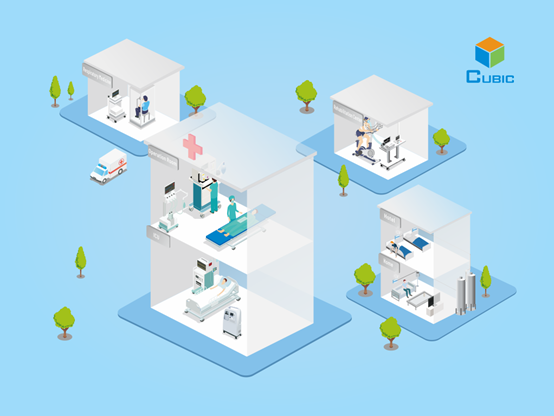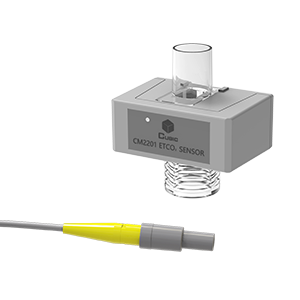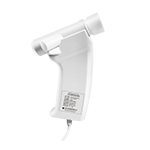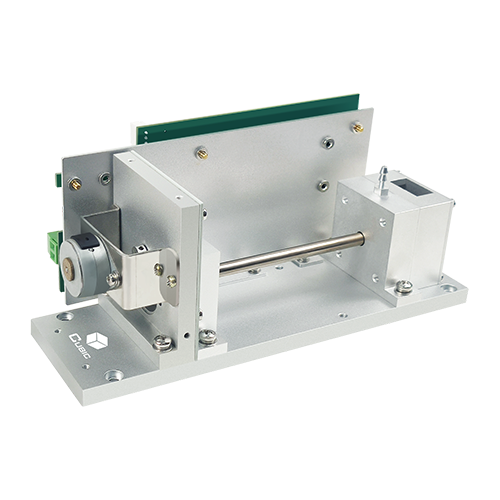Gas sensors are used in practically every industry to measure the concentrations of different gases. However, these sensors have additional responsibilities in the medical and healthcare sectors.

Image Credit: Cubic Sensor and Instrument Co. Ltd
They are not only used for measuring critical medical gases but also for tracking gas flow rate and other essential gas parameters in medical devices like oxygen machines (oxygen concentrators and oxygen generators, for example), anesthesia machines, ventilators, and medical monitoring systems.
With twenty years of experience in the development of gas sensing technologies, Cubic, an international manufacturer of advanced gas sensors and gas analyzers, has accumulated diverse mature sensing technology platforms, including non-dispersive infrared (NDIR), tunable diode laser absorption apectroscopy (TDLAS), and ultrasonic technologies, among others.
Cubic platforms can be used to measure gas concentrations and air volume, as well as to monitor pressure and flow rate in real-time, for a variety of medical sector applications.
Equipped with robust research and development capabilities, as well as manufacturing skills, Cubic is ready to deliver an extensive selection of gas sensors and gas analyzers designed for medical applications.
Gas Sensing Technologies for Medical Use
Gas detection is a relatively mature field: there are many different gas sensing technologies on the market, each with its benefits and limitations.
Cubic leverages a robust portfolio of highly developed sensing technologies - NDIR, TDLAS, and ultrasonic - to deliver unmatched accuracy and reliability while fulfilling the stringent requirements of medical applications.
NDIR (Non-Dispersive Infrared)
NDIR gas sensors operate based on the NDIR principle, which states that certain gases absorb infrared light at specific wavelengths.
The detector captures and quantifies the infrared absorption at these wavelengths, and, through algorithmic analysis embedded in the software, it accurately assesses the concentration of the gas component.
In medical applications, NDIR gas sensors emit infrared light through a sample chamber containing the target gas, such as carbon dioxide (CO2), methane (CH4), and carbon monoxide (CO). The amount of absorbed infrared light correlates with the gas concentration, enabling precise gas measurements.
TDLAS (Tunable Diode Laser Absorption Spectroscopy)
TDLAS technology utilizes a “tunable” laser to emit light at the exact wavelengths absorbed by specific gases.
In healthcare settings, TDLAS gas sensors measure the intensity of light absorption to precisely detect and quantify gases, including oxygen (O2), with fast response times and excellent reliability.
Thanks to these benefits, TDLAS technology is a superior alternative to traditional paramagnetic oxygen detection methods in different medical applications.
Ultrasonic
Ultrasonic gas flow sensors adopt ultrasonic detecting technology and the TOF (time of flight) principle to measure both the gas flow rate and gas composition in binary gases, which involves monitoring and analyzing the changes in acoustic waves as they travel through a gas mixture.1,3
Ultrasonic gas flow sensors are typically equipped with a pair of ultrasonic transducers that can both emit and receive ultrasonic signals.
These transducers, which are positioned at distinct locations along the path of the gas flow, send and receive ultrasonic pulses. The gas flow rate is then calculated through the time difference between ultrasonic wave transmissions.
Since the speed of sound varies amongst gases, the measurements of the speed at which an ultrasonic pulse travels through the gas can correctly determine the gas composition.
In medical contexts, ultrasonic gas flow sensors can be applied in devices like spirometers and oxygen generators to provide precise measurements of both gas composition and flow rates.
Key Applications and Solutions
Oxygen Concentrator
In medical settings, oxygen concentrators provide a continuous and stable supply of supplemental oxygen gas to patients. The ability to deliver a steady flow of oxygen gas depends heavily on reliable oxygen gas sensors that can accurately and quickly measure gas concentrations.
Based on ultrasonic technology, Cubic has developed Gasboard-7500F series, which is able to conduct measurements on binary gases with high lebels of stablity, rapid respinses, and no need for calibrration or maintennance.
With the ability to assess flow rates of up to 40 L/minute, Gasboard-7500F series can be widely applied in family and medical concentrator applications.
Equipped with a full-scale matrix temperature compensation, Gasboard-7500F series ensures highly accurate and reliable gas measurements within its operational temperature range.
Gasboard-7500F series is also certified to fulfill RoHS, REACH, CMC, EMC, and CE standards, assuring compliance with industry benchmarks.4

Image Credit: Cubic Sensor and Instrument Co. Ltd
In addition, Cubic offers ultrasonic Gasboard-7500H series, specifically designed for concentrators with low flow rates of up to 10 L/minute. As an accurate, durable, and cost-effective oxygen sensing solution, Gasboard-7500H series is suitable for use in oxygen concentrator applications.
Based on the time of flight (TOF) measurement principle, Gasboard-7500H series provides highly accurate measurements for both oxygen concentration and flow rate of oxygen gas generated from gas supply in medical care.5

Image Credit: Cubic Sensor and Instrument Co. Ltd
In addition to assessing flow rates of up to 40 L/minute with Gasboard-7500F series and up to 10 L/minute with Gasboard-7500H series, Cubic has also developed Gasboard-7500HA-BC series specifically for pulse oxygen concentrators (PSA oxygen concentrators), which can handle flow rates of less than 2 L/minute.
As an updated variant of Gasboard-7500H series, Gasboard-7500HA-BC offers enhanced accuracy and resolution in measurements. Equipped with full-scale matrix temperature compensation, it boasts great stability. Its compact design allows for easy integration into pulse oxygen concentrator equipment.
Featuring self-calibration, maintaince-free operation, and a long lifespan, Gasboard-7500HA-BC represents a superior cost-effective oxygen sensor solution.
Medical Ventilator
Medical ventilators are important medical devices that use positive pressure to circulate air through the lungs of patients who are unable to breathe properly on their own.
Modern ventilators integrate a variety of sensors that can automatically adapt to changes in lung function or breathing, minimizing required input from medical personnel.
Cubic offers a comprehensive range of gas sensing solutions designed to optimize the fuctionality of ventilators used in both clinical and residential settings, ensuring patients receive tailored support for their respiratory needs.
leveraging ultrasonic technology, Cubic has developed advanced 5-in-1 oxygen sensor, Gasboard-8500FS series, that is able to measure critical parameters of oxygen concentration, pressure, flow rate, temperature, and humidity precisely and quickly at flow rates up to 240 L/minute in ventilation applications.6
In addition, Gasboard-8500FS series is engineered with a drift-free feature that eliminates the necessity for routine calibration. Its compact size enables Gasboard-8500FS series as an excellent option for customized integration. It also has the benefit of a long lifespan.
Due to its core performance, Gasboard-8500FS series is well-suited for a wide range of medical applications, including high-flow nasal cannula oxygen therapy ventilation, positive airway pressure ventilation, anesthetic ventilators, and other breath monitoring equipment.

Image Credit: Cubic Sensor and Instrument Co. Ltd
Anesthesia Machine
The purpose of an anesthesia machine is to deliver precise amounts of anesthetic gases or medications to patients during surgical procedures to maintain anesthesia.
Throughout the process, closely moniroeing key respiratory parameters, including EtCO2 (end-tidal carbon dioxide concentration) and oxygen levels, could ensure the patient’s respiratory function remains normal and safe.
EtCO2 levels can serve as indicators of the body’s physiological condition since metabolic carbon dioxide (CO2) is carried from the blood to the lungs and subsequently exhaled during breathing.
Monitoring EtCO2 during the use of anesthesia machines can assist medical professionals assess a patient’s ventilation status and provide early warning of respiratory compromise.
Based on the dual beam non-dispersive infrared (NDIR) technology, Cubic mainstream EtCO2 sensor module CM2201 has been specially develped to monitor respiratory end-tidal CO2 concentration and respiration rate.
leveraging the NDIR principle, Cubic CM2201 exhibits high selectivity, enabling accurate CO2 concentration measurements without interference from other gases. With the feature of fast response time, CM2201 ensures timely and precise monitoring.
Constructed from durable materials with excellent stability and no wearing parts, CM2201 boasts a long service life and low maintenance costs.
Aside from its core performance, the modular design of CM2201 ensures compatibility and easy integration into monitors and anesthesia equipment with an 8-pin socket.7

Image Credit: Cubic Sensor and Instrument Co. Ltd
In addition to monitoring EtCO2, closely tracking oxygen concentration could ensure that the patient’s breathing oxygen levels remain within a safe range throughout the surgical operation, avoiding situations of oxygen toxicity or hypoxia.
Cubic has specifically designed Gasboard-2510 oxygen sensor for precise oxygen concentration measurement.
Based on the principle of TDLAS (Tunable Diode Laser Absorption Spectroscopy), Gasboard-2510 oxygen sensor could realize high accuracy and excellent repeatability, with a measurement range of 0 % to 100 % and a resolution of up to 0.01.
Utilizing narrowband tunable laser emission targeting oxygen absoption band, Gasboard-2510 achieves high selectivity of oxygen gas. Moreover, it boasts fast response time of less than 170 milliseconds.
As a result, Gasboard-2510 oxygen sensor can be widely applied in anesthesia machines that demand accurate, reliable, and rapid oxygen concentration measurements.2

Image Credit: Cubic Sensor and Instrument Co. Ltd
Simultaneously, to ensure patients receive adequate and consistent oxygen supply during surgery, medical professionals must have access to oxygen flow rate measurements to promptly identify and rectify any oxygen supply issues, ensuring patient safety.
Cubic has designed oxygen flow rate sensors to accommodate varied flow rates: Gasboard-8500FS series, developed to handle flow rates of up to 300 L/minute.
By adpoting ultrasosnic detecting technology and principle of TOF (time of flight) measurement, Cubic oxygen flow rate sensors have remarkable characteristics of excellent stability, high accuracy, fast response, continuous monitoring, etc.
Pulmonary Function Tests
Pulmonary function tests evaluate lung function and help diagnose respiratory conditions. Two critical tests of pulmonary asseement are spirometry and the measurement of diffusing capacity of the lungs for carbon monoxide (DLCO). Spirometry evaluates how effectively the lungs inhale and exhale air, whereas DLCO assesses the lungs’ efficiency in transferring oxygen into the bloodstream.
Cubic’s advanced ultrasonic spirometry and NIDR DLCO solutions provide unparalleled performance in lung function and recovery applications.8
Spirometry measures lung function by monitorig the rate at which air can be inhaled abd exgaled. Cubic offers two complete spirometry sensing solutions: Gasboard 7021 for residential use and Gasboard 7020 for hospital use, which provide quick and accurate readouts of criticle respiratory parameters including VC (vital capacity), FVC (forced vital capacity), and MVV (maximum ventilatory volume).
Developed based on ultrasonic technology, Cubic spirometry sensing solutions realize long lifespan without the necessity of calibration and maintenance.
Both spirometry sensing solutions offer graphic real-time data display and history records checking for better patient information management and tracking.
Gasboard 7021 and Gasboard7020 can also be used to monitor static vital capacity, forced vital capacity, and maximum voluntary ventilation rate.
The accompanying software not only allows automatic BTPS (Body Temperature and Pressure Saturated) correction but also offers comprehensive evaluations of pulmonary functions, further streamlining the respiratory assessment process.9


Image Credit: Cubic Sensor and Instrument Co. Ltd
For a more comprehensive evaluation of pulmonary health, the DLCO test is also used in conjunction to assess lung function by measuring the difference in partial pressure between inspired and expired carbon monoxide (CO).
Based on NDIR technology, Cubic has developed an advanced gas sensor, Gasboard-2050, specidically desigened to measure the diffusing capacity of carbon monoxide in the lungs.
Utilizing a mechanically chopped IR source, Gasboard-2050 boasts a rapid response time (under 300 milliseconds).
Enhanced with an algorithm that compensates for temperature and pressure variations, the device exhibits exceptional accuracy and remarkable stability across a vast spectrum of atmospheric conditions, including fluctuating temperatures and humidity levels.
Aside from its fundamental capabilities, Gasboard-2050 features a modular design that simplifies assembly processes, ensuring high availability and supporting mass production.
Due to its exceptional precision and reliability, Cubic DLCO sensor Gasboard-2050 serves as an invaluable instrument for medical professionals, enabling them to them to assess a wide range of respiratory conditions.10

Image Credit: Cubic Sensor and Instrument Co. Ltd
Cubic has devoted itself to developing a diverse range of gas sensing solutions in response to the growing demand for accurate and reliable medical diagnostics and treatments in the healthcare sector, which is being driven by technological advancements.
With over 20 years of continuous innovation in core technologies of ultrasonic, NDIR, and TDLAS, Cubic provides quality and quantity measurement solutions for gases in a variety of important medical applications.
Cubic’s strong OEM/ODM capabilities enable it to offer a wide range of dependable, precise, and fast-responding gas sensors and gas analyzers, meticulously engineered to support different medical applications and adapted to meet the specific needs of its customers.
In addition to providing high-quality customization solutions, Cubic can also mass-produce its products under strict quality control, ensuring that the company efficiently meets the diverse and large-scale requirements of the healthcare sector.
Cubic will remain steadfast in its dedication to technical advancement and adherence to rigorous standards.
References and Further Reading
- Oxygen Sensor in Medical And Health Application. https://en.gassensor.com.cn/MedicalAndHealth1/index.html.
- Fast Response TDLAS Oxygen Sensor: https://en.gassensor.com.cn/OxygenAndFlowSensor/info_itemid_1249.html.
- Drenthen, J., & Boer, G.: The manufacturing of ultrasonic gas flow meters. Flow Measurement and Instrumentation 12, 89–99 (2001).
- Medical Grade Ultrasonic Oxygen Flow Sensor | Cubic Sensor. (2016). Gassensor.com.cn. https://en.gassensor.com.cn/OxygenAndFlowSensor/info_itemid_301.html.
- Ultrasonic o2 Oxygen Sensor Gasboard for Oxygen Concentrator or Ventilator. (2016). Gassensor.com.cn. https://en.gassensor.com.cn/OxygenAndFlowSensor/info_itemid_112.html
- Ultrasonic Oxygen Sensor in Medical Ventilator-Gasboard-8500FS-L240. https://en.gassensor.com.cn/OxygenAndFlowSensor/info_itemid_1029.html.
- Mainstream EtCO2 Carbon Dioxide Sensors Module-etco2 Sensor Manufacturers. https://en.gassensor.com.cn/CO2Sensor/info_itemid_96.html.
- Enright, M., Paul. Office-based DLCO tests help pulmonologists make important clinical decisions. Respiratory Investigation 54, 305–311 (2016).
- Portable Spirometer for Medical and Home Use. https://en.gassensor.com.cn/Spirometer/list.html.
- DLCO gas sensor for DLCO spirometer Gasboard-2050: https://en.gassensor.com.cn/CO2Sensor/info_itemid_96.html.

This information has been sourced, reviewed and adapted from materials provided by Cubic Sensor and Instrument Co. Ltd.
For more information on this source, please visit Cubic Sensor and Instrument Co. Ltd.